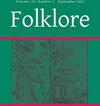表演环境主义:表达文化与生态变化
IF 0.2
4区 社会学
0 FOLKLORE
引用次数: 0
摘要
在我看来,关于如何发现事物,以及有什么需要发现的,心理治疗所做的,可能也需要做的,似乎不适合人种学研究,这是苏弗拉基斯描述他的研究的方式。有时,人们难免会怀疑,这里的潜台词之一是对现代科菲奥特人仍然迷信这一观念的防御性反驳。话虽如此,如果你对现代“超自然信仰”感兴趣,本书的核心部分,即第二章和第三章,Souvlakis报告并借鉴了他与科孚岛的俗人、东正教牧师、民间治疗师和心理健康从业者进行的广泛访谈、焦点小组和对话,非常值得一读。对于页面上呈现的某些材料的性质和状态,特别是关于其编辑和交互上下文,人们可能会提出一些问题。有时它看起来有点过于整洁和精致,我知道,这是民族志的一个常见缺点。然而,这些问题不应被允许减损他的证据的价值和兴趣。很难从其他任何地方找到类似的证据,对于我们这些对这些事情感兴趣的人来说,出版这些材料是非常有价值的。不幸的是,这种赞扬必须受到信心的侵蚀,粗心的编辑和糟糕的学术只能鼓励信心的侵蚀。先不考虑一个相当显著的事实,即人们将徒劳地寻找对这本书主题的有用的工作定义,考虑一下以下选择:索引有六页左右,与正文不同步;在文献讨论中有一些值得注意的缺失,如Joost a . M. Meerlo的(公认古怪的)直觉与邪恶之眼(1971),Edward S. Gifford的《邪恶之眼:视觉民俗研究》(1958)(尽管引用了1960年的一篇论文),以及最奇怪的,Charles Stewart的《恶魔与魔鬼:现代希腊文化中的道德想象》(1991);在第4-5页,迈克尔·夏默被称为夏默,他的书《为什么人们相信奇怪的事情》的出版日期是1998年,而不是1997年(这可能与沙玛1998年的出版日期相混淆);在第31页,有一段关于Wirt“在意大利村庄的苏格兰盖尔区进行的广泛田野调查”的神秘引用;我还可以加更多。所以,基于我已经说过的原因,《基督教希腊东正教社会中的邪恶之眼》是一部需要谨慎阅读的作品,需要适当的批判眼光。然而,关于科孚岛及其人民的定性研究数据使其值得付出努力。本文章由计算机程序翻译,如有差异,请以英文原文为准。
Performing Environmentalisms: Expressive Culture and Ecological Change
psychotherapy makes, and probably requires—about how to find things out, and what there is to find out—do not appear to me suitable for ethnographic research, which is how Souvlakis describes his research. It is sometimes impossible to escape the suspicion that one of the subtexts here is a defensive rebuttal of the notion that modern Corfiots are still superstitious. Having said that, Chapters Two and Three, the heart of the book, in which Souvlakis reports and draws upon his extensive interviews, focus groups, and conversations about the evil eye with lay people, Orthodox clergymen, folk healers, and mental health practitioners in Corfu, are, if you are interested in modern ‘supernatural belief’, very worth exploring. There are questions one might want to pose about the nature and status of some of this material as presented on the page, particularly about its editing and interactional context. On occasions it looks just a little too tidy and polished, which is, I know, a common shortcoming of ethnography. However, these questions should not be allowed to detract from the value and interest of his evidence. It is hard to think of a comparable body of evidence from anywhere else, and to those of us who are interested in such matters, publication of this material is of great value. Unfortunately, this praise must be tempered by the erosion of confidence that careless editing and poor scholarship cannot help but encourage. Leaving aside the rather remarkable fact that one will search in vain for a useful working definition of the book’s subject matter, consider the following selection: the index is six pages, give or take, out of synch with the text; there are notable absences from the discussion of the literature such as Joost A. M. Meerlo’s (admittedly eccentric) Intuition and the Evil Eye (1971), Edward S. Gifford’s The Evil Eye: Studies in the Folklore of Vision (1958) (although a 1960 paper is cited), and, strangest of all, Charles Stewart’s Demons and the Devil: Moral Imagination in Modern Greek Culture (1991); on pages 4–5 Michael Sharmer is referred to as Shermer, and the publication date of his book, Why People Believe Weird Things, is given as 1998, rather than 1997 (which maybe a confusion with Sharma 1998); on page 31 there is a mystifying reference to Wirt’s ‘extensive fieldwork in one of the Scottish Gaelic regions of Italian villages’; and I could add more. So, for the reasons that I have set out, Evil Eye in Christian Greek Orthodox Society is a work that is to be read with caution and an appropriately critical eye. However, the qualitative research data about Corfu and its people make it more than worth the effort.
求助全文
通过发布文献求助,成功后即可免费获取论文全文。
去求助
来源期刊

FOLKLORE
FOLKLORE-
CiteScore
0.60
自引率
25.00%
发文量
0
期刊介绍:
A fully peer-reviewed international journal of folklore and folkloristics. Folklore is one of the earliest journals in the field of folkloristics, first published as The Folk-Lore Record in 1878. Folklore publishes ethnographical and analytical essays on vernacular culture worldwide, specializing in traditional narrative, language, music, song, dance, drama, foodways, medicine, arts and crafts, popular religion, and belief. It reviews current studies in a wide range of adjacent disciplines including anthropology, cultural studies, ethnology, history, literature, and religion. Folklore prides itself on its special mix of reviews, analysis, ethnography, and debate; its combination of European and North American approaches to the study of folklore; and its coverage not only of the materials and processes of folklore, but also of the history, methods, and theory of folkloristics. Folklore aims to be lively, informative and accessible, while maintaining high standards of scholarship.
 求助内容:
求助内容: 应助结果提醒方式:
应助结果提醒方式:


